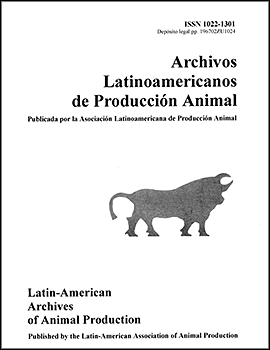
|
Archivos Latinoamericanos de Produccion Animal
Asociacion Latinoamericana de Produccion Animal
ISSN: 1022-1301
EISSN: 1022-1301
Vol. 16, No. 1, 2008, pp. 1-6
|
 Bioline Code: la08002
Bioline Code: la08002
Full paper language: Spanish
Document type: Research Article
Document available free of charge
|
|
|
Archivos Latinoamericanos de Produccion Animal, Vol. 16, No. 1, 2008, pp. 1-6
| en |
Sugar cane ( Saccharum officinarum  ) in substitution to the corn as source ofenergy in broiler chickens in the finishing phase ) in substitution to the corn as source ofenergy in broiler chickens in the finishing phase
Cordeiro, M.D.; da T. R. N. Soares, R.; Fonseca, J.B.; de Souza, C. L. M. & Hurtado-Nery, V. L.
Abstract
Was carried an experiment with the objetive to evaluate the use of five levels of sugar (0, 4, 8, 16 and 32%) in substitution to the corn in the feed of broilers in the finishing phase. 320 chickens with 22 days of age, were randomly distributed for 20 box. The birds received water and feed ad libitum in all experimental period. The diets were isonetrogenous an isocaloric. The performance of the birds was evalueted. The birds were weigthed at 42 days of age and four birds of each experimental unit, two males and two females, were kept without food for a 12 hours. After this period the birds were slaughtered and eviscerated and carcass weight and yield as wells cuts yield were collected. Water, protein and body fat were observed. There was quadratic effect or the ration consumption, being 20.73 the point of maximum intake. The sugar influenced in a positive lineal way the weight and abdominal fat of the males. In the females negative lineal effect was for chest yield. With relations to the fat deposition and protein in the carcass, the levels of sugar didn´t influence in the males, in the females they caused positive linear effect for the fat body deposition.
Keywords
Broiler chickens, carcass yield, fat deposition, sugar cane.
|
| |
| es |
Azúcar de caña ( Saccharum officinarum  ) en substitución de maíz como fuente de energía para pollos asaderos en fase de terminación ) en substitución de maíz como fuente de energía para pollos asaderos en fase de terminación
Cordeiro, M.D.; da T. R. N. Soares, R.; Fonseca, J.B.; de Souza, C. L. M. & Hurtado-Nery, V. L.
Resumen
Fue realizado un experimento con el objetivo evaluar la utilización de cinco niveles de azúcar (0, 4, 8, 16 y 32%) en substitución del maíz en la alimentación de pollos asaderos en fase de terminación. 320 pollos con 22 días de edad, fueron distribuidos al acaso en 20 lotes. Las aves recibieron agua y alimento a voluntad durante toda la fase experimental, las raciones fueron isoprotéicas e isocalóricas. Fueron evaluadas las características de desempeño; a los 42 días de edad las aves fueron pesadas y retiradas 4 de cada unidad experimental, dos machos y dos hembras, que posteriomente fueron sometidas a ayuno de 12 horas y luego sacrificadas y evisceradas, para evaluar peso y rendimiento de canal y de cortes nobles. Tambien fueron observados los contenidos de agua, proteína y grasa corporal. Hubo efecto cuadrático para consumo de ración, siendo 20.73 el punto de maxima ingestión. El azúcar influyó de forma lineal positiva sobre el peso y rendimiento de grasa abdominal en los machos. En la hembras hubo efecto lineal negativo para rendimiento de pechuga. Los niveles de azúcar no influenciaron los contenidos de grasa y proteína en la canal de machos, en la hembras causaron efecto lineal positivo en la cantidad de gordura corporal.
Palabras-clave
Azúcar de caña, deposición de gordura, pollos asaderos. rendimiento de canal.
|
| |
© Copyright 2008 - ALPA. Arch. Latinoam. Prod. Anim.
Alternative site location: http://www.alpa.org.ve/ojs/index.php
|
|
